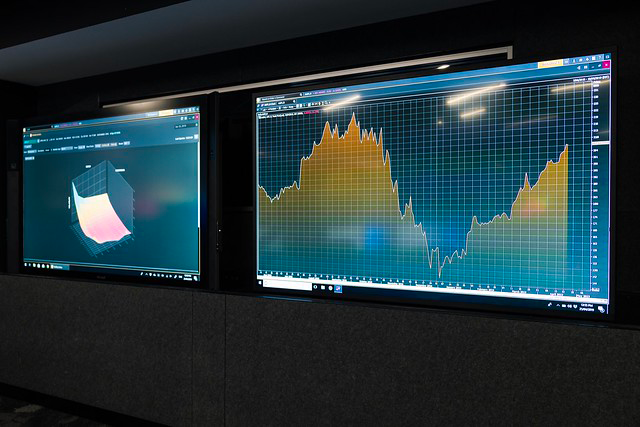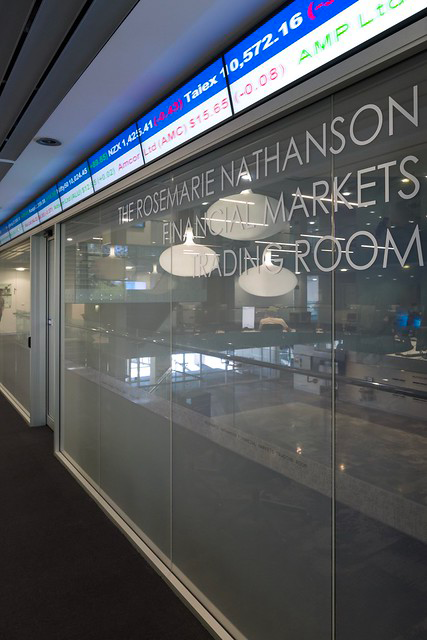University of Western Australia Business School Builds its Own Experiential Trading Floor
The frenetic world of the financial trading floor is about as different from the atmosphere of a university classroom as it is possible to get; yet anyone graduating from a business school without hands-on experience in electronic trading is regarded by many prospective employers as unsuitable to hire. Recognising this, the Business School at the University of Western Australia (UWA) decided that it was critical to provide an opportunity for its students to gain experience on live, industry-standard trading and research systems as part of their training. As Professor Andrew Caminschi from the Business School describes it: “We are narrowing the gap between the world of learning and the world of employment.”
To achieve this, an existing 10 metre by 17 metre space on the first floor of the UWA Business School has been transformed into an electronic trading room that looks and feels like the trading rooms found in any international financial or commodities trading house. The big difference is that this room is designed with the flexibility to also serve as a lecture room or an experimental laboratory at the touch of a control icon.

Coordinated by Prof. Caminschi, a team of UWA staff specialising in AV and IT joined with design specialist 3D Audio Visual to meet the challenge of converting this limited space into a fully functional trading room and classroom. Despite the significant technology requirements for such a facility, the space has a flat concrete floor and a limited ceiling height, which together eliminated the possibility of using a conventional raised-floor system to facilitate the complex cabling, and effectively excluded the use of ceiling-mounted video projectors. While it was a significant challenge to shoehorn 45 trading stations, teaching facilities, and the control room into the available space, some clever design and creative placement of the elements has created a room that feels quite spacious.
AN AVALANCHE OF VISUALS
Before you even enter the room, there is a sense of the busy trading environment within. Along the outer wall of the room, and visible to everyone in the business school foyer, is an impressive live stock exchange ticker. This 11-metre, (23,040 × 540 pixel) display consists of 12 x half-height HD (1920 × 540) monitors driven by a server in the control room equipped with a pair of Matrox C-380 six-head video cards. The frosted-glass external wall is also used as the screen for two rear-projected video feeds visible to passers-by. However, at a touch on the room’s control screen, the projectors are doused and the frosted LCD-glass wall dissolves to transparency, providing an uninterrupted view of the spectacular trading room within.
On entering the trading room, the sheer number of video screens is at first overwhelming. If the 45 trading stations, each with dual 580mm (23-inch) monitors weren’t enough, around the walls are three pairs of videowalls, each of 4 x 1,400mm (55-inch) panels, for the teaching displays, and three groups of 3 x 1,100mm (43-inch) screens for live news feeds. Then there are the five ‘pods’ of 6 x 580mm (23-inch) screens, located overhead in the centre of each trading station cluster to carry live news feeds. Finally, the main teaching position has a height-adjustable 2,100mm (84-inch) Microsoft Surface Hub interactive touchscreen, together with a matching 2,100mm (84-inch) LCD panel.

While on paper, the sheer number of screens may sound outrageous, the placement of the news feed monitors and teaching display videowalls is a direct consequence of the limited space in the room. To squeeze the required number of trading stations in such a confined space necessitated that the desks be laid out in a series of connected semi-circles, with all workstations facing in toward the workstations on the opposite curve. While this face-to-face configuration is not particularly uncommon in trading rooms and other screen-based workplaces, it is a very difficult and unusual layout for a teaching space. As few of the workstation positions have a clear line of site to the teaching position for lectures and tutorials, the teaching screens and news feed screens must be replicated around the room to provide an adequate view to all student positions. The five ‘pods’ of overhead news screens in the junctions of the curved desks can also be discreetly lowered back into the desk to assist with sightlines to the lecturer’s position when the room is in classroom mode.
Programme sources for the news feed monitors, teaching displays and window projection include internet feeds, cable television set top box decoders, a simulation server in the control room, and BYOD inputs at the teaching position. The available internet feeds include direct stock market streams, while the cable television feeds include CNN, Bloomberg TV, and MSNBC News. All video is distributed via a fibre-optic, TCP/IP network, using AMX SVSI encoders and decoders, running low-latency JPEG 2000 codecs. The feed to each display or video wall is independently assignable. Audio for the room comes from JBL ceiling speakers and in-ceiling subwoofers, powered by a Crown amplifier, and driven by Biamp digital signal processing.
All operations and configuration for the facility are controlled by an AMX NetLinx central system controller and an N-Series SVSI video controller through a graphical touch interface on a Wi-Fi-linked iPad. This system controls every element, from the room lighting and the assignment of audio and video feeds for every device in the room, to the lifts that raise and lower the news feed pods, and the transparency of the Ethernet-controlled glass walls. The simple control interface for the room in each of its guises: Trading room, teaching space and experimental lab were programmed by 3D Audio Visual to be readily operated by academics, students and support staff.

TRADING ON THE TECHNOLOGY
While the trading room’s technology may be impressive, its only role is to provide a range of learning experiences for students. As Prof. Caminschi put it: “Instead of reading a dry textbook that looks at historic market movements, this lab allows our students to work with the most current tools and data to track real-world events in real time.”
To achieve this, every dual-screen workstation is loaded with the same financial technology tools that are used in the places where students will be employed. Each has a full, live licence for both major trading and research packages: The Bloomberg Terminal and its major competitor, the Thomson Reuters (now Refinitiv) Eikon system. There are also feeds from the Australian Stock Exchange Market Source service and the CME Globex trading and information system operated by the Chicago Mercantile Exchange. Each workstation is also loaded with the TT (Trading Technologies) Platform for access to trading tools and live data for trade futures, options markets, other derivatives and cryptocurrencies. The TT platform has the capacity to conduct simulated live trading in a sandbox environment, without spending any money. In the next few months TT will also be offering a replay function that can display historic data movements. Students will be able to look at past news events from the CNN archives, then track the ensuing market responses on TT.
THE MULTI-FUNCTION RESEARCH TOOL
In its research role the lab can readily be used for such activities as market research; however, the university sees that perhaps its most valuable capability may be that the system can be configured to engage the lab participants as research subjects. As each terminal is equipped with a headset, microphone and a webcam, the lab could quite easily be configured to use for screen-related behavioural studies, while observers control and monitor the experimental procedures, either through the room’s one-way observation mirrors, or from the overhead camera feeds that can be viewed in the control room. The possible uses for a controlled environment with large video screens, a sound system and 45 computer workstations are only just being considered by other departments within UWA.
The trading room project for the School of Business was completed in a very tight time window between February and September of 2017, yet still managed to come in under budget: great accomplishments for the UWA and 3D Audio Visual teams. In the year that the project has been serving the university, it has met and exceeded all UWA expectations and hasn’t revealed any flaws in the design and execution of the design. The final measure of success comes from Prof Caminschi, Director of the Rosemarie Nathanson Financial Markets Trading Centre: “Our students can step onto a trading floor and feel completely comfortable with the tools on offer”.





d6795920-eaf6-408e-b064-10b247156888.png?sfvrsn=6773b7ba_1)
